�

�
History of the Aluminium Alloy V8
�The story of the Buick V8 engine which found its way across
�
the Atlantic to power a generation of Rover and Leyland vehicles.
�
�
as published in British V8 Newsletter, Volume XV Issue 3, December 2007�
�
Re-printed unedited by exclusive written permission of "Autocar".
�
This article originally appeared in their issue for the week ending November 20, 1976.�
�
by Chris Goffey�
�
Autocar is often prophetic. But the author of a technical review of the then new Buick aluminium V8 �
engine, writing in the issue of 23 September 1960, could have had little idea just how accurate he �
was being when he commented, "We will wager that the most widely copied engine of the next 10 years �
will be the superb new aluminium V8 by Buick." In fact, it was only a chance encounter with the �
engine by Rover managing director Bill Martin-Hurst that led to this particular prophesy being �
fulfilled in this country. But fulfilled it has been, with the highly successful Rover V8 engine �
powering a wide variety of Leyland vehicles over the past nine years. �
�
Work started on the design of the Buick engine back in 1950, with first experimental engine being �
a cast iron unit 3.85 litres capacity. In the same year, a design for aluminium was prepared, with �
the displacement going up to 4.15 litres. By 1952, both of these engines had been road tested, �
under an overall GM plan to come up with a power unit that would be lighter than conventional cast �
iron engines, and which would allow them to build a lighter, better handling car offering improved �
fuel consumption with little or no performance penalty. At this time aluminium looked to be the way �
for engine manufacturers to go in the search for weight saving since the later, more sophisticated �
thin-wall iron casting techniques were then in their infancy. Work started on the present unit at �
the GM design laboratories in 1957 with the first unit running in the summer of 1958 before being �
finally turned over to the Buick division for production engineering and design.�
�
�
Buick managed to design an aluminium alloy with a high silicon content that gave wear characteristics �
on the engine test bed which were generally superior to cast iron, confounding the critics who said �
that they could not have an aluminium cylinder wall with an aluminium piston running in it in a mass �
production engine. However, one problem they simply could not overcome was the scuffing of the bores �
by the piston rings in a cold start. It was mainly for this reason that Buick elected to go for iron �
cylinder liners cast in place in a block with a more modest silicon content in the aluminium alloy. �
Buick had ruled out any idea of using wet liners because the American engineering techniques do not �
allow for the handwork precision of wet liners in European designs, and they were most concerned �
about the problems of water leakage from a poorly sealed liner. �
�
In fact, the feeling against wet liners was so strong that Buick later admitted they would rather �
of abandoned the aluminium alloy concept altogether then to go to wet liners. The liners in �
production were pre-heated to prevent chilling in the mould and held in place by mandrels as the �
block was cast. Buick used gravity casting in metal dies with sand cores for the water jackets. �
The problems of varying expansion rates in the metal between block, head, and rockers were solved �
by using hydraulic lifters, already common practice in American engineering. The heads of the Buick �
unit were also cast in dies with intricate sand cores.�
�
�
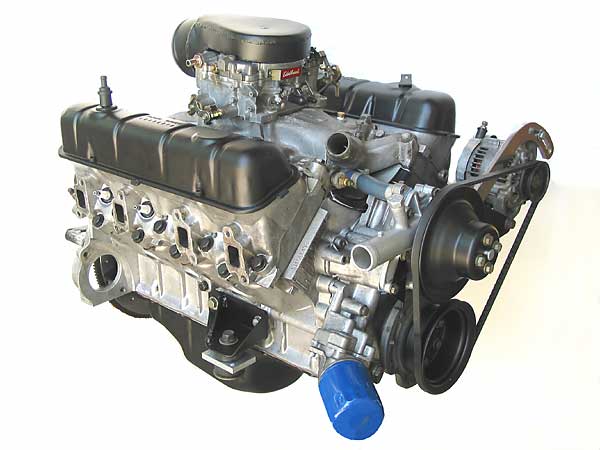
�
Buick 215 aluminium V8: in this trim it produces approximately 185hp at 4800 rpm.
�
�
The engine was installed in a number of well-known American cars after the production troubles were �
ironed out, notably the Buick Special, Pontiac Tempest, and also the Oldsmobile F85 Cutlass after �
Oldsmobile engineers had designed different pistons, heads and manifoldings. The Buick Special �
engine gave 155bhp gross at 4,600 rpm and produced 220 lb.ft. of torque at 2,400 rpm for an all-up �
weight of 318lb. �
�
(British V8 editor's note: when British authors, including especially Rover/Leyland marketing hacks,�
write about the Buick 215 they tend to omit any mention of higher-spec variants. In actuality, a �
very high proportion of General Motors customers selected "optional equipment" high-performance �
versions of these engines. The 155bhp, 8.8:1 compression, 2bbl carbureted engine described above �
was just the base model. Tens-of-thousands of Buick Specials and all Buick Skylarks were shipped �
from the factory with higher-horsepower, higher-compression, 4bbl carbureted engines. Depending on �
model year, these engines produced between 185 and 200bhp. Oldsmobile similarly made their �
four-barrel, higher compression engine standard on "Cutlass" and an option on the base-model "F85". �
The Oldsmobile "Jetfire" variant was turbocharged and produced 215bhp at 4800rpm and 300 ft.lbs. at �
3200rpm.) �
�
After all the investment and engineering time that went into the Buick engine, it seems sad that its �
useful working life in production was so short. By 1964 the engine had been virtually abandoned with �
the more sophisticated thin wall iron casting techniques being perfected and the American �
disenchantment with small engines and the compact car. In fact, although 750,000 aluminium engines �
were produced in various form, it was also successfully run as a 5 litre engine with the cylinder �
liners deleted and the block cast in iron instead of aluminium. A further 750,000 5 litre iron �
engines from the same tools were subsequently built.�
�
(British V8 editor's note: It's so hard to communicate the sheer difference in scale between General �
Motors and the British auto industry. GM produced more aluminium V8 engines in just three years than �
Rover built in total. The 5 litre engine discussed here, better known stateside as the "Buick 300", �
was in fact a very, very similar and obviously derivative design although it's a bit of a stretch to �
say that the same tools were used to build it. The Buick 300 crankshaft and heads can in fact be �
bolted onto a Buick 215 block, and as an interesting aside, the 1964 model year Buick 300 was fitted �
with aluminium cylinder heads as standard.) �
�
It was at this stage that the Rover managing director Bill Martin-Hurst took his historic stumble �
across an aluminium Buick engine lying on the floor of an experimental shop in the Mercury Marine �
Company's base in Wisconsin. Martin-Hurst was in America talking to Mercury about gas turbine �
engines for outboard motors, at that time being most anxious to give his ailing gas turbine division �
a boost. In fact, when he showed Mercury the drawings of the engine his company produced they were �
more interested in the diesel version of the Land-Rover engine than in his turbines. They had a �
contract to supply diesels to Chinese fishing junks, and they were having trouble with the Mercedes �
diesels they were using to fulfill the contract. The head of the Mercury concern, Cark Kiekhaefer �
told Martin-Hurst that the V8 lying on the shop floor was a Buick, an aluminium engine out of a �
Skylark that they ad been playing around with for power boat racing purposes.�
�
Martin-Hurst recalls that with a friend he had been taken out in a Skylark on a previous visit to �
America, and he had formed the opinion then that it had been 'terribly nice'. His thoughts went �
straight back to England with the problems Rover were having with the six cylinder version of the �
Rover 2000 which marketing maintained they needed so badly. The prototype had been built, and �
Martin-Hurst had driven it, but he was worried that the weight of the big old 3 litre six in the �
front of the 2000 made the car extremely nose heavy. 'Is this engine available?' he asked Kiekhaefer �
and was told that it had just gone out of production. The engine was measured and weighed against a �
Rover 2000 engine which Mercury had already received from Rover, and proved to be just 12 lb heavier �
and within an inch of the overall length. �
�
Kiekhaefer told him to go see Ed Rollert at General Motors to ask if he could use the engine in a �
Rover car, and in the meantime the Buick that Martin-Hurst had seen was crated up and dispatched to �
England. Martin-Hurst went to the New York Motor Show and had breakfast with Ed Rollert who was �
'jolly nice' but who said he could not authorize licensing the engine. Rover would have to approach �
GM International. Martin-Hurst went there to see Copeland, the ex-head of Vauxhall and told him of �
his interest in the unit. Copeland said he would look into the matter. �
�
Back in England, the Buick was sitting in Rover's experimental shop and creating not a little �
interest. Martin-Hurst tried to get Peter Wilks to put the V8 in a 2000 body but Wilks resisted, �
telling him that everyone was too busy, and that he wasn't to waste everyone's time. It was no good �
putting the engine in a car because they would never get permission to use it from GM anyway. But �
Martin-Hurst persisted, and it was finally agreed that Ralph Nash in the competitions department �
should do the job. The engine was duly installed with little modification and apart from an �
over-long propshaft which tended to flex too much, it was a great success.�
�
�
Enjoying this article? Our magazine is funded through the generous support of readers like you!
�
To contribute to our operating budget, please click here and follow the instructions.
�
(Suggested contribution is twenty bucks per year. Feel free to give more!)�
�
Martin-Hurst went down to a board meeting in London and without telling Spen King what it was asked �
him to drive the car back. King climbed in, started up and then switched off again. 'What have we �
here William?' he asked, and Martin-Hurst told him about the V8. Spen drove it back to Rover and �
climbed out with the remark that it was the first Rover he had ever driven which was not �
underpowered. Martin-Hurst went back to Copeland and discovered that nothing had happened about his �
enquiry because GM could not believe they were serious. Martin-Hurst was soon able to convince them �
just how serious he was, and with the help of 'AB' they negotiated a license with GM - a generous �
license as it turned out, which opened the flood gates of technical information. Up until this point, �
Rover had had great trouble getting much information about the engine out of GM, but now they were �
able to acquire all the original service records, drawings and 39 complete engines which the Buick �
factory still held and which Rover negotiated for a negligible sum. �
�
Then came the problems of taking an American manufactured engine and attempting to manufacture it in �
this country with British component suppliers and foundries. Martin-Hurst soon contacted Buick's �
chief engine designer, Joe Turlay, who was then within 18 months of retirement. He confided to �
Martin-Hurst that he was not doing too much at Buick anymore, being so near to retirement, so �
Martin-Hurst asked him to come to England and help in the conversion of the engine to British �
manufacture. Turlay said he was worried about his pension, but Rover won GM agreement that his �
pension would not be affected, and he and his wife were brought over to England and installed in a �
flat in Solihull on a salary of £20,000. �
�
When Turlay arrived he was puzzled by the Rover engineers' insistence on more power and a higher rev �
range. The Buick ran out of revs at 4,700 and was getting unhappy at that. Rover wanted at least �
5,200 and possibly 5,500. 'Why do you want all those revs?' asked Turlay. 'People just don't drive �
like that.' So he was sat alongside a Rover test driver and proceded to hurtle him across country �
and up the M6 at over 100mph in those pre-limit days, to show him what sort of treatment the engine �
would have to withstand. After that experience he returned shattered, with an insight into what �
Rover wanted. �
�
Turlay was invaluable at interpreting the original drawings. Rover could not understand why the �
engines did not conform to the drawings. Turlay was able to point out where things had been changed �
in production, the changes not being recorded on the original drawings. At one point he wandered �
into Martin-Hurst's office and said that he was unhappy. He felt that he was not earning his salary. �
'How many people have you talked to this week?' asked the Rover managing director kindly. 'About �
half a dozen I suppose.' replied Turlay. 'And what were the questions?' 'Oh, well, they wanted to �
know why the crankshaft webs had a smaller radius than we showed on the drawings. I told them that �
after we made about 50,000 engines we started to get crankcase breakages, and we discovered that �
by reducing the radius of the webs we got around the problem.' 'What do you suppose that sort of �
information is worth to Rover? You can't put a price on it!' said Martin-Hurst. �
�
Decisions were soon made about the production of the engine in England. In the first place, the �
gravity die casting with liners in place was carried out in America on an old automatic transmission �
die casting machine, a transverse machine where the bock was cast on its end. Enquiries were made �
about the drawings and the methods were met with the answer that the man who had set it all up had �
died long since. �
�
British casters were unhappy about the technique and soon decided that the only feasible method of �
production in England was to sand cast the block and then to press fit and shrink the liners in. �
There were surprisingly few problems. Birmingham Aluminium got it right almost on the first attempt, �
and with very few changes the engine went into production.�
�
�
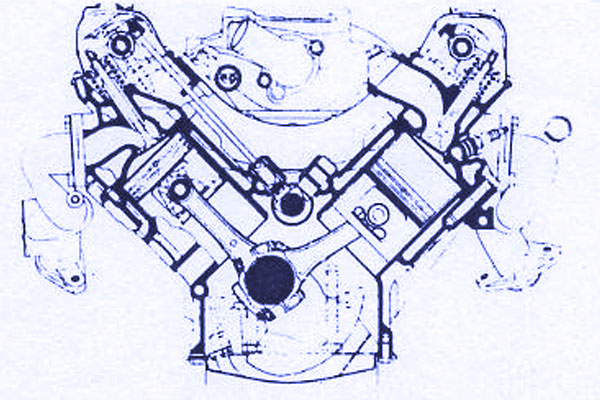
�
Cross section of the V8 unit - note the centre camshaft with hydraulic tappets still
�
supplied from America to this day.
�
�
Rover altered the oil feed to the rocker shaft in an attempt to cut the rocker shaft and rocker arm �
wear they were experiencing with test engines. They were very worried by the problem, but Turlay �
with his American engineering attitudes to engines was unable to see the need for concern. The �
problem was that the underside of the rocker arm was wearing away, and at the same time cutting into �
the case-hardened rocker shaft until it had cut quite a groove, but Turlay pointed out that the �
hydraulic pushrods took up the slack anyway, and the engine stayed quiet so what was all the �
excitement about? The engine would hold together despite the problem for well over 100,000 miles, �
so why worry? By that time no one would want the car. Rover engineering was outraged by the �
suggestion, and tried in turn anodized rockers, then tin-plated rocker bearings, and eventually �
settled on electro-plated nickel for the surfaces. �
�
(British V8 editor's note: both complete rocker-arm-and-shaft assemblies can be replaced in about �
one half hour. They're easily accessed by simply removing the valve covers. The replacement parts �
are relatively inexpensive. Since the engine is equipped with hydraulic lifters, no valve-lash �
readjustment is required. To this day, American engineers still wonder what those Rover engineers �
were so worried about!)�
�
They also changed from the American 'Armasteel' specifications for the crankshaft to a nodular �
steel, a feature about which Turlay was very dubious. �
�
With Birmingham Aluminium casting the heads and blocks in sand instead of die casting, the Rover �
engines were at once in better tune than the original Buicks. When a head is die cast it inevitably �
bows and when it is then machined flat the combustion chambers at each end will be smaller in �
volumetric capacity than those in the centre. Rover did not have to contend with this problem. �
�
(British V8 editor's note: since the shrinkage of die-castings is predictable and very consistent �
from one part to another off a given die design, contending with this "problem" wouldn't have taken �
much more than an afternoon.)�
�
The accessories for the engine would also have to be British. Rover looked at and tested a compound �
Rochester carburetor, but soon decided that with European cornering forces it was unsuitable as the �
engine tended to cut as the fuel centrifuged in the float chamber. Thus the decision was taken to go �
with twin SU's although this would mean introducing bulges into the bonnet - something the engineers �
had hoped to avoid. �
�
(British V8 editor's note: it meant other things too. SU carbs are fine, but they need to be �
synchronized which adds labor and maintenance costs. Furthermore, they tend to need choke enrichment �
in warmer weather and for longer in cool weather than American-style carburetors.)�
�
Lucas were also approached about the ignition side (the Buick engine had been fitted with an �
AC-Delco single contact breaker distributor) - this would be Lucas's first single-contact breaker �
8-cylinder distributor - and just developed in time for final production. A feature of the�
distributor was the very long drive shaft, supported in the die cast timing chest on the front of �
the engine which also contains the water pump. The lower end of the distributor has to drive the �
oil pump, a Hobourn-Eaton unit. The only item of American manufacture in the entire unit remained �
the hydraulic tappets principally because the Diesel Equipment Co., of Grand Rapids could turn �
them out at such a low price and at such good quality that it simply was not worth going to a �
British supplier. The hydraulic tappets are brought across to this day.�
�
�
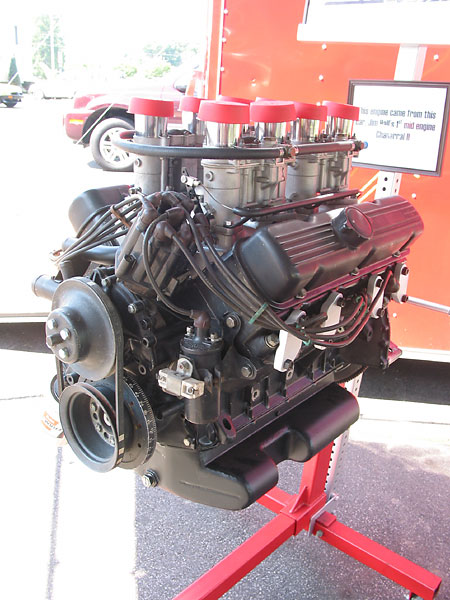
�
Modified Oldsmobile 215 engine from one of Jim Hall's famous Chaparral II racecars, circa 1963.
�
(Specifically, it's from Chaparral 2A #002 as driven by Hal Sharp. This particular racecar was
�
later powered by a Chevrolet V8 engine. The Oldsmobile V8 is now owned by D&D Fabrications.)
�
�
William Martin-Hurst was convinced that the engine he had bought for Rover was going to power many �
models for many years, and he was already eager to see it put to more sporting use. He asked Jack �
Brabham, then using the Buick engine in Repco form in his Formula 1 GP cars for a scrap engine, but �
Brabham declined. At that time Brabham had won two World Championships with the Repco, the engine �
being developed in its final form to a four camshaft unit. But the American engineering firm Traco �
were more than happy to show Rover what they could do, and at one stage a 'full house' 350bhp Traco �
unit was shipped to Rover for assessment. "I think we still have it," says Martin-Hurst. The �
Company made a collection of all the go-faster items available for the engine from Iskenderian �
camshafts to Hallibrand manifolds and they assured themselves that if the need arose they could �
be certain of having all the development work needed for raising the power of the engine ready to �
hand. Sadly that has never really happened at Rover, and it has been left to individuals to play �
with the Rover unit to gain the increases in power it is so obviously capable of delivering. �
�
Notable among the development exercises was that of GKN. They took a standard Rover V8, installed �
it in the infamous GKN 47D Lotus, with a succession of modifications to manifolds, camshaft, careful �
attention to balancing, a longer throw crankshaft, bigger pistons, and lightweight flywheel. GKN �
eventually had the engine delivering a remarkable 296bhp at 6,500 rpm. Later on, Bill Shaw entered �
a full race Rover 3500 in club racing in this country, with factory support. �
�
�
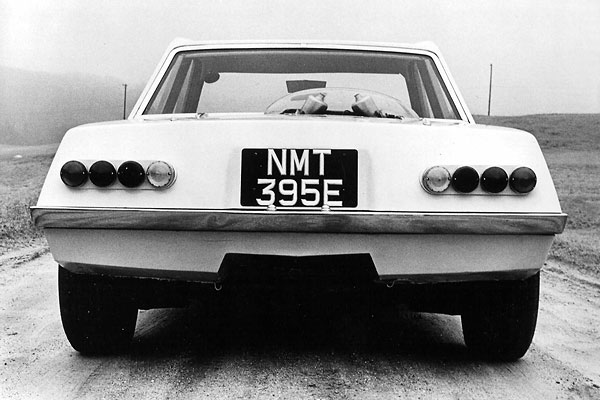
�
The Rover P6 BS prototype (which was renamed "Leyland Eight GE")
�
�
There were any number of variations for the V8 in those early days. It was fitted to the �
revolutionary P6 BS mid-engined sports car prototype, designed by Spen King and Gordon Bashford, �
and killed off in the Leyland merger. This was a most interesting version of the engine. It ran �
facing the rear of the car with the final drive case into the sump, driven by a small prop shaft �
running from the gearbox at the front of the engine. Power was transmitted to the gearbox from the �
end of the crankshaft by Morse chain and a modified Rover 2000 gearbox was used lying on its side. �
Rover devised a new exhaust system for the car which gave equal pulses without the need for �
cross-over pipes. They also fitted 2" SU carburetors, with none of the usual complicated silencing �
air cleaner trunking. The result was a very quick car indeed, topping 140mph, accelerating from �
0-60 mph in 7.0 seconds. The engine was mounted on one side, resulting in extra weight on the front �
and rear wheels on the right hand side. However, with left hand drive, and the driver only on board, �
the car would be perfectly balanced. �
�
(British V8 editor's note: Leyland did in fact "kill off" any hope of a Rover mid-engined Grand �
Touring car being advanced to production. However, they didn't exactly kill off the prototype. �
Instead, they renamed it the "Leyland Eight GE" and took it to the 1968 New York International �
Automobile Show for display in the Leyland booth. Leyland senior management apparently didn't �
see value in building up the Rover brand identity in North America in preparation for introducing �
the upcoming Rover 3500S model. Instead, they preferred to promote the Leyland company name �
generally. Go figure. We've published the original Leyland Eight GE press materials. Please �
see the link below.)�
�
Another one-off using the V8 was a styling exercise made by David Bache, Rover styling director, �
which was a two door fastback on the 3500, with a rather Chrysler Alpine like front grille and the �
nickname 'Gladys'. This car was to have been marketed as the Alvis GTS, but was another victim of �
the merger.�
�
The original V8 installation in the 3.5 saloon and coupe proved very successful. The lighter weight �
of the unit improved the handling of the big car enormously, and in no time the 3.5s were to be seen �
whistling around the country at great rates of knots. The conversion of the engine to 3500 form �
announced in April 1968 involved different manifolds, with the down-pipe being taken from the centre �
of the exhaust manifold, instead of from the rear end, as in the original Buick and 3.5 installation. �
At first the car was available only with automatic transmission, but in 1971 the 3500S was �
introduced, featuring a redesigned exhaust system with the down pipes joining into one pipe much �
further back down the system. In fact, the two pipes from the manifolds are of larger diameter than �
the 3500 pipes and combined with the extra length of down pipe this meant the back pressure was thus �
much reduced over the standard 3500. The 3500S also introduced improved SU carburetors, designated �
HIF 6 (Horizontal Integral Float-Chamber) which were claimed to provide more stable carburetion �
during conditions of hard acceleration, braking and cornering. At the time of the announcement of �
the 3500S (in October 1971) Autocar commented that "relieved of the sobering influence of the�
torque converter, the engine has assumed a decidedly sporting character. Even so, it has lost none �
of its silky smoothness and a delightful flexibility." The car developed 152bhp (DIN) at 5,000 rpm �
and 203.5 lb.ft. of torque at 2,750rpm.�
�
�
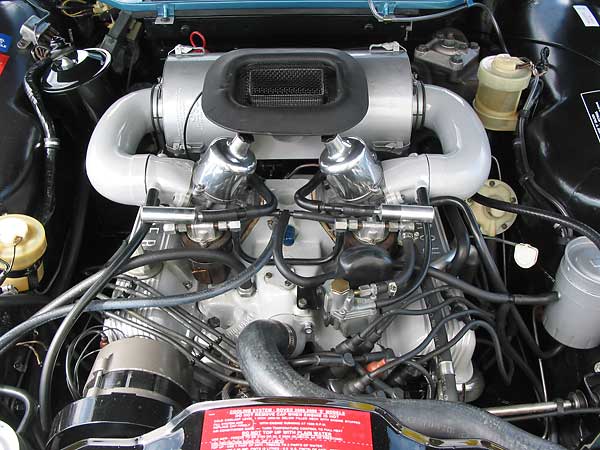
�
The aluminium V8 engine as installed in Lance LaCerte's 1970 Rover 3500S.
�
�
One of the more major changes to the engine had come in June 1970 when the Range Rover was announced. �
The introduction of the Range Rover unit had called for a new timing chest die to allow for the �
raising of the water pump to accommodate a starting handle dog and a power take-off point. The �
compression ratio was reduced to a nominal 8.5 to one (the production engines varying under �
manufacturing tolerances between 0.25 and 0.75 anyway) from 10.5 in the car form. The reduction in �
compression ratio allowed the Range Rover to run on 2 star fuel, fed to the engine through Zenith �
CD 2S carburetors on a special manifold, instead of the SU's of the car engine. The air cleaners �
were supposed to incorporate a one way valve to allow any water which might find its way into the �
air cleaner to drain 'harmlessly away', but on one Range Rover at least Autocar found that it was �
possible to drown the engine in an especially deep water splash. The metal fan was changed for a �
moulded plastic type (Rover had experienced fatigue failures with fan blades slicing into the bonnet �
of cars) and the starter solenoid was moved further up the engine to keep it out of harm's way. The �
Range Rover developed a gross maximum of 156bhp at 5,000 rpm with a peak torque of 205 lb.ft. at �
3,000 rpm. �
�
Another major production change for the unit came with the ill-fated P76 saloon engine, first �
produced in June 1973. This was a fundamentally revised engine from the 3500, featuring an enlarged �
block to make a 'square' engine of 3.5 inch bore and stroke. This brought the capacity to 4,416cc �
and the engine developed 192bhp at 4,250rpm and 285 lb.ft. of torque at 2,500 rpm, suggesting �
improvements above and beyond the capacity change to head design, breathing, and exhaust. The �
Australians did much of the development of the unit themselves, no doubt in co-operation with Traco, �
and the exact details of what was done, why, and how are not very clear. It is known that they went �
for a twin-choke Stromberg carburetor instead of the two SU's and the central manifold design was �
fundamentally revised. �
�
One of the most altered engine from the manifolding point of view was for the MGB V8. The design and �
development work for the unit was done at Abingdon, and the most obvious difference was the new �
inlet manifold moving the carburetors to the back of the unit to permit the retention of the �
standard bonnet. The engine used for the MGB V8 (announced in August 1973) had more in common with �
the Range Rover unit than the Rover 3500. It shared the same dished pistons and 8.5:1 compression �
ratio, but with an AC-Delco alternator instead of the Lucas unit. The SU HIF6 twin carburetors have �
forward facing inlet tracts into a plenum chamber in the centre of the Vee, a system which MG �
claimed gave them increased low speed torque over the standard unit. The engine met ECE 15 �
regulations, with bi-metallic strips controlling the temperature of the air flow into the �
carburetors. As installed in the MG the unit delivered 137bhp (DIN) and 193 lb.ft. torque at 2,900 �
rpm.�
�
�
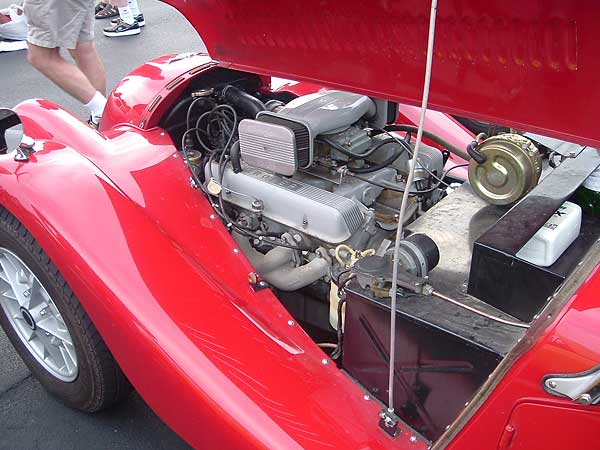
�
The aluminium V8 engine as installed in Paul Foster's 1970 Morgan Plus 8.
�
(Note: the Holley carb and Holley "Hi-Tek" air cleaner aren't "original".)
�
�
Another famous application of the V8 in a sports car was of course the Morgan V8. The story of �
this car started in 1966 when Peter Wilks asked Peter Morgan to merge with Rover to produce a sports �
car fitted with the V8. Morgan said he liked the engine, but he didn't like the idea of a merger. �
Wilks agreed, and negotiations for Morgan to use the engine went ahead smoothly until the Leyland �
takeover, when there was a major hiccup. Leyland wanted permission from GM to use the engine in a �
Triumph sports car, so permission was sought for both the Morgan and the Triumph. GM replied that �
they had no objection to Morgan using the engine, but would not commit themselves on the Triumph. �
In the meantime, Peter Morgan had Maurice Owen shoehorn a Buick V8 into a modified Plus Four, and a �
very successful car it proved to be. It is still owned by the factory. �
�
After two years had gone by, still with no decision, Morgan approached Harry Webster with a view of �
getting a meeting with Donald Stokes to try and confirm an agreement. Harry tried to wean Morgan �
away from the Rover engine by showing him the range of Triumph engines, but Morgan remained convinced �
that the Rover V8 was the unit he wanted. A couple weeks later, Webster came down to the Malvern �
factory with George Turnbull, who was to give the final approval. Turnbull went off for a blast �
around the hills in the car, came back most impressed with it, and told Morgan "You can have the �
engine as long as you don't take too many of them." The car was exhibited at the 1968 Motor Show �
and was an immediate hit. �
�
Morgan's use of the engine involves a fair amount of dismantling. The unit comes in a production �
line package, and Morgan takes off the power steering pump and alternator since they dispense with �
the viscous coupled fan using an electric fan in its place. They alter the clutch operation, taking �
the arm through the top of the bellhousing instead of the side, and they fit the original 3.5�
manifold with a special exhaust system. Morgan, of course, are still being supplied with V8s in the �
latest and most revised form from the SD1, the latest model being the Plus 8-77 with the 5 speed �
gearbox. �
�
The use of the faithful old V8 for SD1, the pride of Leyland's new marketing strategies, called for �
some fundamental re-thinking. The engineering staff were faced with calls for more power, a higher �
rev-limit, and the eventual need to meet strict American emission regulations. �
�
The first step was to alter the valving in the hydraulic tappets to delay the point at which they �
started to "pump up", and after that to improve the breathing. Changes were made to the inlet and �
more especially to the exhaust manifolds, with dual outlets per bank and much better extractor �
effect, and new single valve springs were introduced. To complete the change, after exhaustive �
tests, Lucas electronic ignition was fitted. To test the system, Rover had it running for 6,000 �
miles of city driving, followed by 6,000 miles around the 'de-tox' route, followed by 6,000 miles �
at maximum speed around MIRA, all without attention to the ignition. To get the vehicle to work flat �
out without wearing out a set of tires around MIRA's banking every 10 laps, they erected a six foot �
high box on the roof of the Rover to drag down maximum speed, but still make the engine work on full �
throttle. After that they went back and did a further 6,000 miles in traffic. It seems amazing after �
all this testing that the ignition is still giving so much trouble in service. �
�
Long nose Champion N12Y plugs were adopted to go with the electronic system. The oil pump design was �
improved with higher output especially at lower speeds, and the water pump housing and impeller were�
changed to reduce power loss at high speeds. The piston ring depth was reduced to cope with the �
higher revs, and the temperature controlled air intake valve was introduced into the air trunking. �
The engine develops 155bhp at 5,250 rpm and 198 lb.ft. of torque at 2,500 rpm. �
�
Those then are the major applications of the Rover engine. There have of course been countless other �
applications to specials and one-offs, and many developments of the engine in competition work, but �
the unit stands out for its reliability, its kindliness to different mounting brackets (nothing �
seems to vibrate and fall off in service) and its durability. The army made all sorts of demands on �
it for the application to the new military V8 Land Rover, even demanding that the soldiers must be �
able to stand on it to service it. It has taken all the abuse without complaint, and sadly for �
British engine designers remains one of the best engines we have ever seen in British cars.�
�
British V8 editor's note: The cutaway drawing displayed above was included with our copy of the �
original Autocar article. We added photos, selected from our files and from other sources, and �
also added captions. On the advice of automotive historian and writer�
Aaron Severson, we corrected Autocar's misspelling of�
two names: the Vice President and General Manager of GM's Buick Division was Ed Rollert (not Rollart)�
and the Senior Engineer who led the design of the aluminium V8 and came to England to help Rover's�
conversion work was Joe Turlay (not Turley).�
�
� This article is part of a set of SIX articles about Rover! If you enjoyed this article, check out:
� Rover 3500S Press Release (circa 1969)
� 1970 Rover 3500S Specifications and Pricing
� Leyland "Eight GE" Concept Car Press Release (circa 1968)
� Rover P6 Design Innovations
� Lance LaCerte's Restored 1970 Rover 3500S
�
� Want to know more about the venerable aluminum V8? Here are two more classic articles:
� Buick Motor Division: "The New Buick Aluminum Engine"
� Speed Mechanics: "There's Soupability in GM's Aluminum V8's"
�
�

